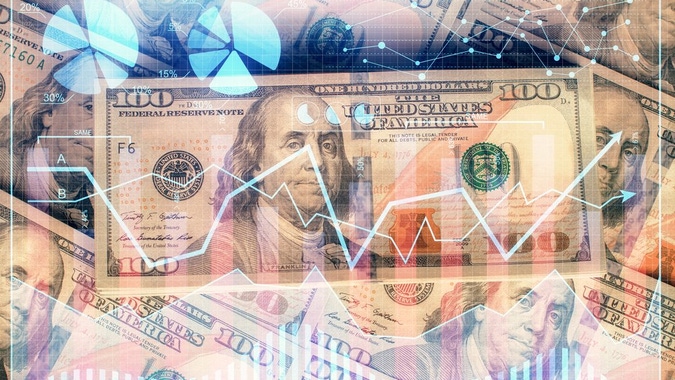We’ve all heard the headlines of inflation hitting four-decade highs and its negative effect on operating margins and consumer spending. Inflationary pressures have caused raw materials prices to skyrocket made worse rising logistics costs and supply chain disruptions. Soaring grocery and gas prices have soured consumer sentiment and spending habits. To combat inflation, the Federal Reserve has made a full 180 degree hawkish turn from a year ago when they were overusing the term “transient” (temporary) in reference to inflation. They’ve accelerated to 75 basis point rate hikes to slow the rapid pace of inflation, which hit a 40 year high of 9.1% for June 2022. Inflation hits everyone, but not everyone is affected the same. This has caused a negative correlation within consumer spending that is also causing divergence within industries and among peers.

MarketBeat.com – MarketBeat
Rates Rise, Spending Falls
Wages are not rising at the pace of inflation, and this is causing consumers to adjust their spending habits. While they turn their spending more towards the necessities, they are also taking a hit on disposable income from the higher interest rates for credit card, loan, and mortgage payments. The Fed rate hikes have slammed the U.S. equity markets down (-14%) on the year stoking a material change in consumer sentiment. Consumer discretionary items like apparel are being passed over for consumer staples like eggs and vegetables. People reach for the necessities when time get tough. However, the impacts are affecting lower income households more than higher-income households. Even higher income households are searching for bargains. This differentiation can also be found in the stock market.
The Haves
High-income and wealthier consumers are less affected by the impacts of inflation. This is illustrated by premium brand companies feeling less pain since its customers can weather inflation better. Premium athleisure apparel maker Lululemon (NASDAQ: LULU) smoked its Q2 2022 earnings with 25% same store sales growth as direct-to-consumer (DTC) growth of 42%. Revenues grew 28.8% YoY as they beat analyst estimates by $0.34 per share. They raised their full-year EPS guidance to come in between $9.75 to $9.90 versus $9.44 analyst estimates on surging revenues between $7.865 billion to $7.94 billion versus $7.69 billion consensus analyst estimates. Luxury retailer Capri Holdings (NASDAQ: CPRI) owns premium brands Versace, Michael Kors, and Jimmy Choo. They saw revenues climb 8.5% YoY and raised its fiscal 2023 EPS to $6.85 versus $6.74 consensus estimates. They expects revenues to grow to $5.85 billion to $5.95 billion versus $5.84 billion consensus estimates.
Big and Little Box Retailers
In a recession, it would be logical for discount retailers to benefit as consumers flock to cheaper prices. Warehouse club giant Costco (NASDAQ: COST) is seeing gangbuster business as it saw July 2022 comparable same store sales spike 10% with net sales up 10.8% to $16.85 billion. Costco sells both consumer staples (groceries) and consumer discretionary items, but its scale enables them to pass on volume discounts to its members. Grocery stores are the epitome of consumer staples, and they do benefit from inflation. For example, Kroger’s (NYSE: KR) is scoring big from food inflation and robust at-home consumption trends as they grew earnings by 12.5% and revenues by 9.3% to $34.64 billion in its Q2 2022. It’s worth noting that its private label (generic and cheaper but higher margin) brands saw accelerated growth of 10.2% in same store sales.
The Have Nots
Inflation impacts lower-income households the hardest, as even the discount consumer discretionary retailers can’t avoid the impact. Kohl’s (NASDAQ: KSS) felt the pain as their lower-income household demographic customers pulled back discretionary spending. This was evidenced by its Q2 2022 earnings miss as revenues fell (-8.1%) YoY. The Company slashed its full-year EPS estimates to $2.80 to $3.20 versus $4.19 consensus analyst estimates. They guided full-year revenue expectations to fall (-5%) to (-6%). The department store sells mostly consumer discretionary items like clothes, toy, and home products but not necessities like groceries like Target (NYSE: TGT) and Walmart (NYSE: WMT). Discount retailer Five Below (NASDAQ: FIVE) sells items priced $1 to $5 to mostly a teen demographic. They sell mostly candy, toys, novelty items, games, and cosmetics which explains why their same store sales tanked (-5.8%) in its Q2 2022 earnings. They had to lower their full-year comps to fall (-5%) to (-2%). They are hoping their Five Beyond (above $5) store-within-a-store prototype will help drive growth. Videogames are a discretionary spend and gamers are getting more frugal. This was evidenced by Roblox (NASDAQ: RBLX) seeing its engagements rise as average daily users grew 21% YoY to 52.2 million spending 11.3 billion hours on its platform, up 16.6% YoY. However, this didn’t result in more spending as its bookings actually dropped (-3.8%) YoY in its Q2 2022.
The Day After 9/11, This Family-Owned Jam Company Lost All of Its Airline Business. But One Son’s Strategic Rebrand Has Brought Lasting Success.
The Art of Active Listening Requires Leaving Your Ego Behind
Using This Color in Your Facebook Ads Could Increase Your Click-Through Rate
Almost 3 Decades Ago, I Wrote Myself a Check for $1 Million, When I Had Nothing. Here’s Why.
This Entrepreneur’s Wellness Tech Platform Was Inspired By His Grandma’s Garden
Here Are the 7 Traits You Need to Get Rich in the Restaurant Industry
Yankee Candle Founder’s $23 Million Estate Comes With an Indoor Water Park and Two ‘Car Barns’